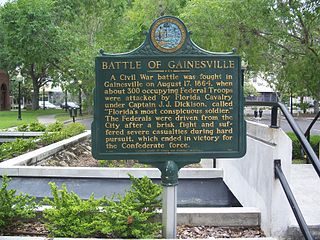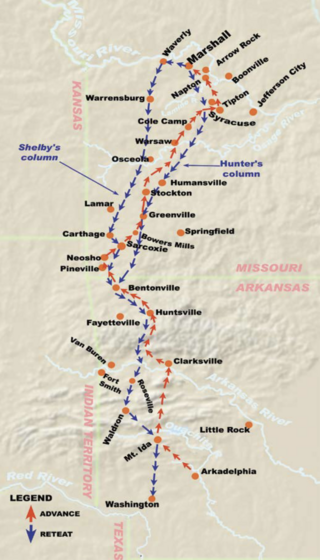
Grierson's Raid was a Union cavalry raid during the Vicksburg Campaign of the American Civil War. It ran from April 17 to May 2, 1863, as a diversion from Maj. Gen. Ulysses S. Grant's main attack plan on Vicksburg, Mississippi.

The Battle of Westport, was fought on October 23, 1864, in modern Kansas City, Missouri, during the American Civil War. Union forces under Major General Samuel R. Curtis decisively defeated an outnumbered Confederate force under Major General Sterling Price. This engagement was the turning point of Price's Missouri Expedition, forcing his army to retreat. The battle ended the last major Confederate offensive west of the Mississippi River, and for the remainder of the war the United States Army maintained solid control over most of Missouri. This battle was one of the largest to be fought west of the Mississippi River, with over 30,000 men engaged.

Morgan's Raid was a diversionary incursion by Confederate cavalry into the Union states of Indiana, Kentucky, Ohio, and West Virginia during the American Civil War. The raid took place from June 11 to July 26, 1863. It is named for the commander of the Confederate troops, Brigadier General John Hunt Morgan. Although it caused temporary alarm in the North, the raid failed.
The Battle of West Point, Georgia, formed part of the Union campaign through Alabama and Georgia, known as Wilson's Raid, in the final full month of the American Civil War.

The Battle of Gainesville was an American Civil War engagement fought on August 17, 1864, when a Confederate force defeated Union detachments from Jacksonville, Florida. The result of the battle was the Confederate occupation of Gainesville for the remainder of the war.
The 8th Ohio Cavalry Regiment was a regiment of Union cavalry raised by the state of Ohio for service during the American Civil War. It served in the Eastern Theater, primarily in West Virginia and then in the Shenandoah Valley region of Virginia.
Wilson's Raid was a cavalry operation through Alabama and Georgia in March–April 1865, late in the American Civil War. U.S. Brig. Gen. James H. Wilson led his U.S. Cavalry Corps to destroy Confederate manufacturing facilities and was opposed unsuccessfully by a much smaller force under Confederate Lt. Gen. Nathan Bedford Forrest.

Florida participated in the American Civil War as a member of the Confederate States of America. It had been admitted to the United States as a slave state in 1845. In January 1861, Florida became the third Southern state to secede from the Union after the November 1860 presidential election victory of Abraham Lincoln. It was one of the initial seven slave states which formed the Confederacy on February 8, 1861, in advance of the American Civil War.

McNeill's Rangers was an independent Confederate military force commissioned under the Partisan Ranger Act (1862) by the Confederate Congress during the American Civil War. The 210 man unit was formed from Company E of the 18th Virginia Cavalry and the First Virginia Partisan Rangers. After the repeal of the Act on February 17, 1864, McNeill's Rangers was one of two partisan forces allowed to continue operation, the other being 43rd Battalion Virginia Cavalry. Both of these guerrilla forces operated in the western counties of Virginia and West Virginia. The Rangers were known to exercise military discipline when conducting raids. However, many Union generals considered Captain John Hanson McNeill (1815–1864) and his men to be "bushwhackers," not entitled to protection when captured, as was the case with other prisoners of war.

Shelby's Raid, also known as Shelby's Great Raid, was a Confederate cavalry incursion into Arkansas and Missouri during the American Civil War in 1863. Led by Colonel Joseph Orville Shelby, the raid took place from August 21, 1863, to November 3, 1863, covering over 800 miles across territories in west central and northwest Arkansas, as well as southwest and west central Missouri.
The Missouri State Militia was a federally funded state militia organization of Missouri conceived in 1861 and beginning service in 1862 during the American Civil War. It was a full-time force whose primary purpose was to conduct offensive operations against Confederate guerrillas and recruiters as well as oppose raids by regular Confederate forces. The militia at one time numbered more than 13,000 soldiers, but this force was reduced to 10,000 soldiers, by the United States government.
The Second Battle of Dranesville, also known as the Ambush at Anker's Shop, was a small cavalry skirmish that took place between Confederate forces under Colonel John Mosby and Union forces under Captain James Sewall Reed east of Dranesville, Virginia in Loudoun County near present-day Sterling on February 22, 1864, as part of Mosby's operations in Northern Virginia in the American Civil War. After successfully defending a raid into "Mosby's Confederacy" by Cole's Maryland Cavalry, the following day Mosby led his Rangers against a second raid by Reed. The action resulted in a Confederate victory.
The Battle of Newton was a minor skirmish that took place in the small town of Newton, Alabama, on 14 March 1865, during the final days of the U.S. Civil War. It was fought between local Home Guard troops and elements of the 1st Florida Cavalry (US), who had invaded the Wiregrass region of Alabama. This operation had not been approved by Brigadier General Alexander Asboth, commanding Union forces in Pensacola, Florida, and was in fact a violation of Ashboth's operational order.
The Battle of Vernon, Florida was a minor skirmish of the American Civil War that took place on September 28, 1864, near the town of Vernon, Florida. Coming a day after the larger Battle of Marianna, this conflict involved a company of Home Guard troops from Vernon who were going to the aid of their Confederate compatriots in that city. Unbeknownst to the Southerners, their route had taken them straight toward the withdrawing Federal column under Brigadier General Alexander Asboth, which was returning to their main base at Pensacola after their victory at Marianna. The two forces met on a wooden bridge across Hard Labor Creek in Washington County; refusing to heed Union demands to disperse, the badly-outnumnered Floridians chose to resist and were quickly defeated, with most of them being taken prisoner.

The 12th Texas Cavalry Regiment was a unit of mounted volunteers recruited in Texas that fought in the Confederate States Army during the American Civil War. The regiment was enrolled in state service in September 1861 and in Confederate service the following month. The regiment fought at Whitney's Lane, Cotton Plant, and L'Anguille Ferry in 1862, Goodrich's Landing in 1863, and Blair's Landing and Yellow Bayou in 1864. The unit also participated in numerous skirmishes and scouts. It disbanded in May 1865.

The 27th Texas Cavalry Regiment, at times also known as Whitfield's Legion or 1st Texas Legion or 4th Texas Cavalry Battalion, was a unit of mounted volunteers that fought in the Confederate States Army during the American Civil War. First organized as the 4th Texas Cavalry Battalion or Whitfield's Legion, the unit served dismounted at Pea Ridge and First Corinth. Additional companies from Texas were added and the unit was upgraded to the 27th Texas Cavalry Regiment or 1st Texas Legion later in 1862. Still dismounted, the unit fought at Iuka and Second Corinth. The regiment was remounted and fought at Holly Springs in 1862, Thompson's Station in 1863, and at Yazoo City, Atlanta, Franklin, and Third Murfreesboro in 1864. The regiment surrendered to Federal forces in May 1865 and its remaining soldiers were paroled.

The Battle of Riggins Hill was a minor engagement in western Tennessee during the American Civil War. A Confederate raiding force under Colonel Thomas Woodward captured Clarksville, Tennessee, threatening Union shipping on the Cumberland River. Several Union regiments led by Colonel William Warren Lowe advanced from nearby Fort Donelson and drove off the Confederates after a struggle lasting less than an hour. The action occurred during the Confederate Heartland Offensive but only affected the local area.

The Battle of Egypt Station was an engagement in Mississippi that took place during a successful Union cavalry raid during the American Civil War. A 3,500-man Union cavalry division under Brigadier General Benjamin Grierson defeated Confederate troops led by Franklin Gardner and Samuel J. Gholson. Grierson's raiding cavalry left Memphis, Tennessee on 21 December and first demolished a Confederate supply depot at Verona. Moving south while wrecking bridges and track along the Mobile and Ohio Railroad, the Union raiders encountered the Confederate defenders at Egypt Station. After their victory, Grierson's cavalry headed southwest to Vicksburg which it reached on January 5, 1865. The raiders destroyed a large amount of Confederate supplies and also damaged the Mississippi Central Railroad. Some of the men captured by Grierson's raiders proved to be former Union soldiers who volunteered to fight for the Confederacy rather than languish in prison camps. When John Bell Hood's army retreated into northern Mississippi after the Battle of Nashville, it was unable to obtain supplies because Grierson's raiders had damaged the railroad so badly.

The 3rd United States Colored Cavalry was a regiment in the United States Army organized as one of the units of the United States Colored Troops during the American Civil War. The regiment was originally formed in October 1863 at Vicksburg, Mississippi as the 1st Mississippi Cavalry Regiment. The unit soon began taking part in expeditions near Vicksburg. In February–March 1864, the regiment saw action at Yazoo City. After being renamed the 3rd U.S. Colored Cavalry in March 1864, the regiment continued to participate in raids, including the Yazoo City expedition in May. In December 1864, the unit took part in a successful raid led by Benjamin Grierson during which the Battle of Egypt Station and other actions were fought. The regiment operated near Memphis, Tennessee, until April 1865, after which it returned to Vicksburg for occupation duties. The soldiers were mustered out of federal service in January 1866.

Rousseau's Opelika Raid saw 2,700 Union cavalry led by Major General Lovell Rousseau raid deep into Alabama in the Atlanta Campaign during the American Civil War. The successful raid began at Decatur, Alabama, and was only opposed by minimal forces of the Confederate States Army. The Union raiders rode south-southeast across the state destroying Confederate supplies and public property. They wrecked as much as 30 mi (48.3 km) of the Montgomery and West Point Railroad near Opelika, Alabama. The Union cavalry then turned northeast and joined the army of Major General William Tecumseh Sherman near Marietta, Georgia, while sustaining few casualties.












